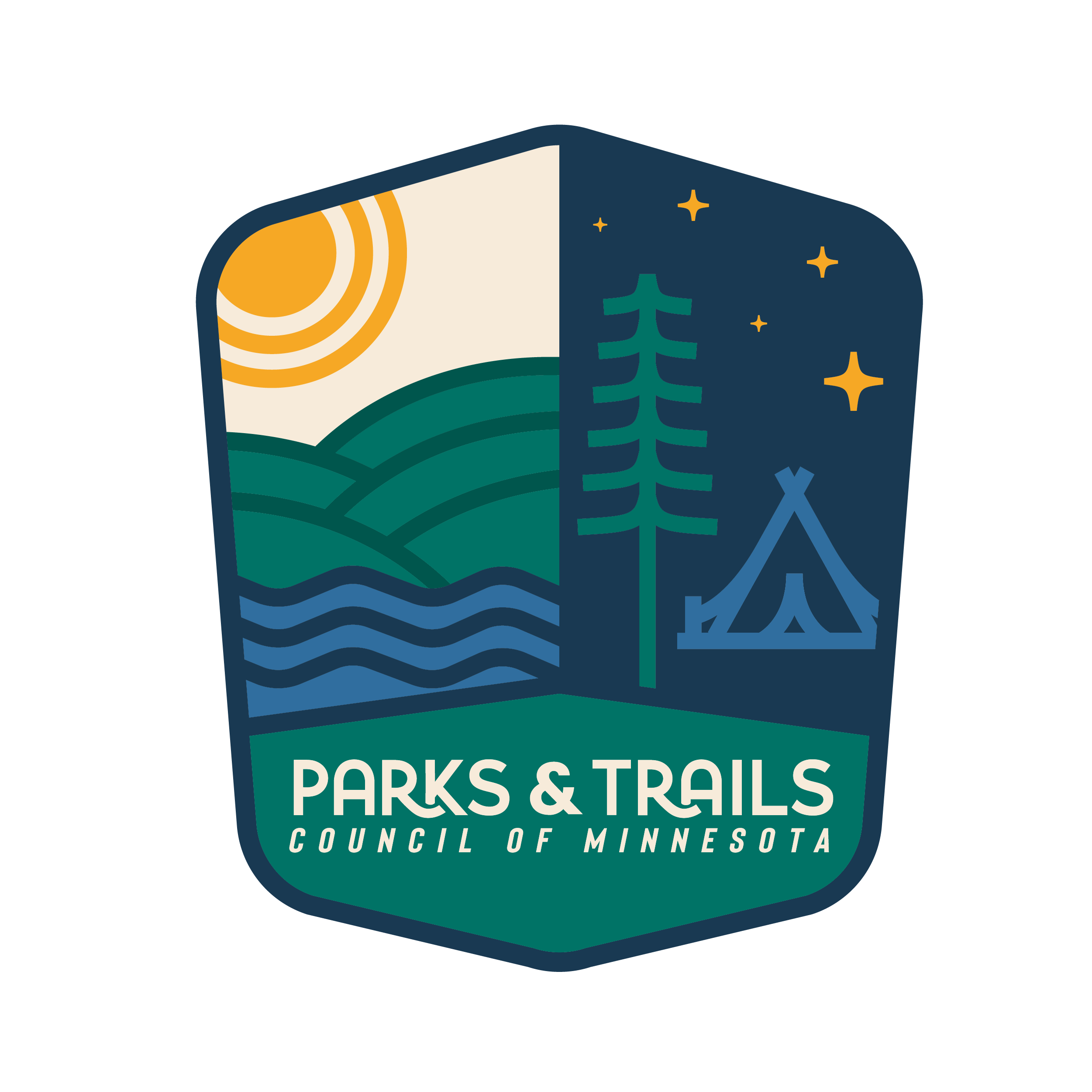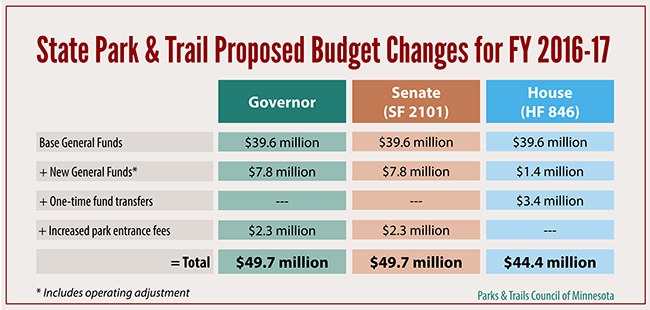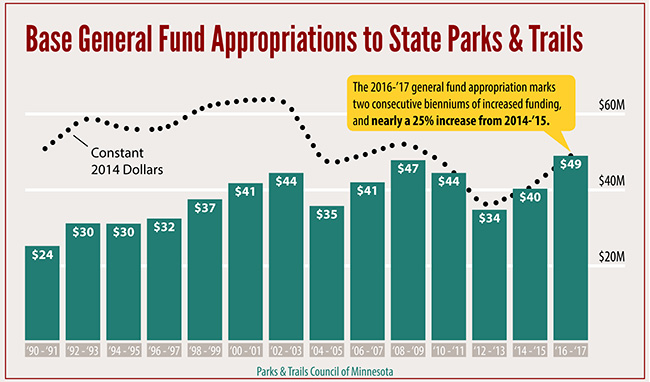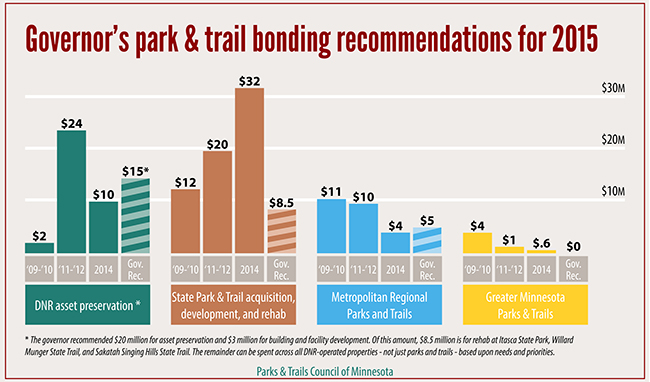- Home
- Advocacy News
- Parks and trails budget taking shape at the capitol
Parks and trails budget taking shape at the capitol
This week, the environmental finance committees in both the House and Senate released budget bills that will fund Minnesota’s state parks and trails for the next two years. We are happy to report both recognize the importance of our state parks and trails and have proposed funding increases.
You’ll notice that while similarities exist between the House and Senate proposals, there are key differences. Not only does the Senate propose a much larger overall funding increase, their budget also relies mostly on general funds. As a public good, it makes sense to pay for our state parks and trails with general funds rather than one-time fund transfers. For these reasons, Parks & Trails Council strongly prefers the Senate proposal over the House’s. Our goal moving forward is to make sure the Senate bill is the one that ultimately ends up as law. Now is a good time to reach out to your legislators and ask them to support the state park and trail funding included in S.F. 2101. Tell them:
- Investments in parks and trails are an investment in our health, economcy, and great outdoor way of life; and,
- The fund fund increase in S.F. 2101 amounts to less than one dollar per Minnesotan, and of all the things we pay for with our tax dollars, our parks and trails are well worth it.
Since differences exist between the House and Senate budget bills, the next important step is for selected members of both chambers to sit down together, compare differences, and agree how to combine the two versions into one budget bill to present to the governor. We’ll keep you posted when that happens.
Both the House and Senate bills are promising in that they recognize current funding for state parks and trails is inadequate. The Senate budget (SF 2101), following Gov. Dayton’s lead, is proposing to increase this general fund appropriation by nearly 20%. Additionally, the governor and Senate are proposing roughly $2 million in increased revenue by increasing park entrance fees from $5 to $6 for a daily pass and $25 to $30 for an annual pass. This funding increase, according to the Minnesota DNR, is just enough to maintain basic service levels at state parks and help operate newly designated parks and recreation areas. In contrast to the governor and Senate, the House budget (HF 846) proposes increasing general funds by only 4%, but also includes one-time transfers of $3 million from a dedicated landfill account to help cover the cost of our state parks and trails. The House budget does not include any park entrance fee increases.
The Senate bill also authorizes a new Mississippi Blufflands State Trail between Red Wing and Lake City and appropriates $50,000 for a trail master plan.
Parks & Trails Council has long believed the general fund is the best way to pay for state parks and trails, and is appreciative that the governor, House, and Senate all propose an increase. While general funds are still well below historical levels when adjusted for inflation, the upcoming biennium is looking to become the second straight in which parks and trails received a general fund increase.
In regards to funding Metropolitan Regional Parks and Trails, the House budget unfortunately reduces general funds from $5.7 million to $4.7 million by singling out the Minneapolis Park and Recreation Board. Gov. Dayton had initially made the same recommendation, but reversed course in his revised March budget. The Senate budget includes the full $5.7 million for Metropolitan Regional Parks and Trails, which Parks & Trails Council supports.
BONDING UPDATE: After weeks of speculation, Gov. Dayton finally released a $842 million bonding proposallast week. Many legislators around the capitol have expressed their desire to wait until next year to pass a major bonding bill, so time will tell where the governor’s recommendation leads. Parks & Trails Council has been advocating for park and trail rehabilitation projects to be included in a 2015 bonding bill. While the governor’s recommendation offers a start towards that goal, it funds parks and trails at lower levels than past years and doesn’t include any local park and trail projects in Greater Minnesota.
The governor’s bonding recommendation includes $20 million for DNR asset preservation, $3 million for DNR buildings and facilities development, and $5 million for Metropolitan Regional Parks and Trails. Out of the $20 million for asset preservation, which is a government term for rehabing and restoring existing facilities, Gov. Dayton line-itemed $8.5 million for rehabilitation projects at Itasca State Park, the Willard Munger State Trail, and the Sakatah Singing Hills State Trail. Historically, state parks and trails have received more than $8.5 million in major bonding bills, so we’ll be working to increase that number as the bonding debate unfolds. Bonding for state park and trails projects is especially important as our state system nears its 125th birthday.
We’ll also be working to include bonding dollars for important park and trail projects in the Metropolitan area and Greater Minnesota. Bonding was historically a very important funding source for grants supporting Greater Minnesota, but has been declining for years. Restoring bonding dollars for local parks and trails throughout Greater Minnesota is crucial for improving outdoor recreation opportunities across our state.
News Categories
Recent News
-
We have a new CRM December 11, 2024
-
Vote yes on Lottery proceeds October 29, 2024
-
Two Friends Groups receive ... August 28, 2024
-
Share your opinion on fundi... August 27, 2024
-
DNR Update: Next Steps in t... August 26, 2024



